Physical Address
304 North Cardinal St.
Dorchester Center, MA 02124
Lev and Eckner made the appropriate statement that no two cases of tetralogy are exactly the same. Although that is fundamentally true, the characteristic anatomy permits its instant recognition as a phenotypic entity. It is appropriate that we continue to use the term named in honor of Arthur Louis Etienne Fallot, who described the combination of an interventricular communication, biventricular origin of the aorta, muscular obstruction within the right ventricular outflow tract, and right ventricular hypertrophy ( Fig. 35.1 , left ).
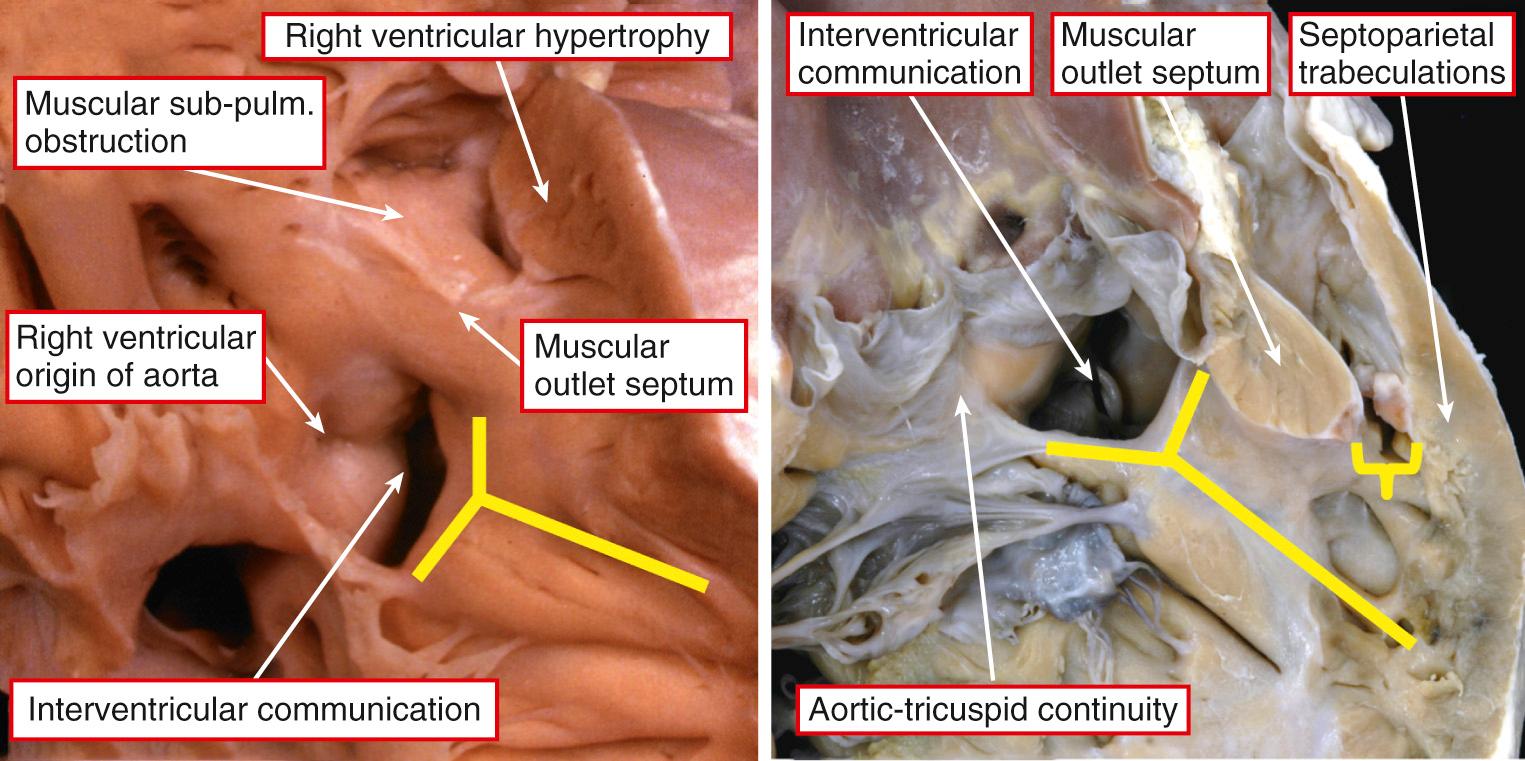
Hearts with this phenotypic morphology had been described prior to Fallot's description. His contribution was to note that the combination of lesions accounted for the majority of cases of “la maladie bleu,” or cyanosis, seen at autopsy. Maud Abbott introduced the concept of a tetralogy and its eponym, which has stood the passage of time. Arguments continue, however, regarding the essence of the malformation and which variants should appropriately be described within the eponym. When obstruction within the right ventricular outflow tract is minimal, it can be hard to distinguish tetralogy of Fallot (TOF) from the variant of ventricular septal defect with aortic overriding, sometimes described as the Eisenmenger defect. When obstruction is complete, the condition represents the most common variant of pulmonary atresia with ventricular septal defect (correctly described as TOF with pulmonary atresia under such circumstances). The single feature underscoring the phenotypic findings is anterior and cephalad deviation of the septal insertion of the outlet septum relative to the septomarginal trabeculation, usually combined with abnormal septoparietal trabeculations ( Fig. 35.1 , right ). Within the hearts fulfilling this criterion, there is ample room for significant individual variation. This variation is the focus of anatomic introduction to this chapter, placing emphasis on the major differences from the normal heart.
Of infants born with congenital heart disease, approximately 3.5% will have TOF, which is 0.28 per 1000, or 1 in 3600, live births. Males and females are equally affected. As with so many congenital cardiac anomalies, precise etiology is unknown. The majority of cases are sporadic. Rubella in the first trimester of pregnancy has been implicated in a small number of cases, whereas viruses have been isolated from cases with severe pulmonary arterial hypoplasia. Keeshond dogs were bred to produce a spectrum of inherited malformations of the ventricular outflow tracts, which included anomalies similar to TOF. The findings indicated a polygenic model of inheritance in which the genes act additively to produce the spectrum of maldevelopment. The lesion is also known to be linked with abnormal migration of cells from the neural crest. A significant proportion of cases have microdeletions of the q11 region of chromosome 22, known to produce Di George syndrome, and the velocardiofacial syndrome, also known as the conotruncal anomaly face syndrome.
Almost all babies born with TOF, no matter what its variant, survive surgical intervention and reach adult life. Consequently, questions of inheritability in offspring are important. It has been known for some time that the incidence of congenital cardiac disease is higher among children born to women with congenitally malformed hearts. For parents with tetralogy (mother or father), the risk of heart disease in their children is approximately 5%. If, however, the affected parent has a sibling with the same or a similar cardiac anomaly or already has a child with heart disease, the risk is significantly increased. Careful genetic counseling and testing, if not already performed, should be offered prior to pregnancy.
As already discussed, the phenotypic feature of the lesion is anterocephalad deviation of the insertion of the muscular outlet septum relative to the limbs of the septomarginal trabeculation coupled with abnormal septoparietal trabeculations, which are usually, but not always, hypertrophied (see Fig. 35.1 , right ). The narrowing between these components produces stenosis of the subpulmonary infundibulum. In the normal heart, however, it is not possible to recognize a muscular outlet septum, although such an entity is found during cardiac development. With normal development, as the aorta is transferred to the left ventricle, the structures that produced the embryonic septum are buried between the limbs of the prominent septomarginal trabeculation, with the latter feature formed by compaction of the initial right ventricular trabeculations. Thus in the normal heart it is possible to recognize only a muscular supraventricular crest ( Fig. 35.2 , left ) formed by the ventriculoinfundibular fold, which supports the freestanding infundibular muscular sleeve distally. The posterior wall of the sleeve separates the infundibular cavity from the aortic root (see Fig. 35.2 , right ).
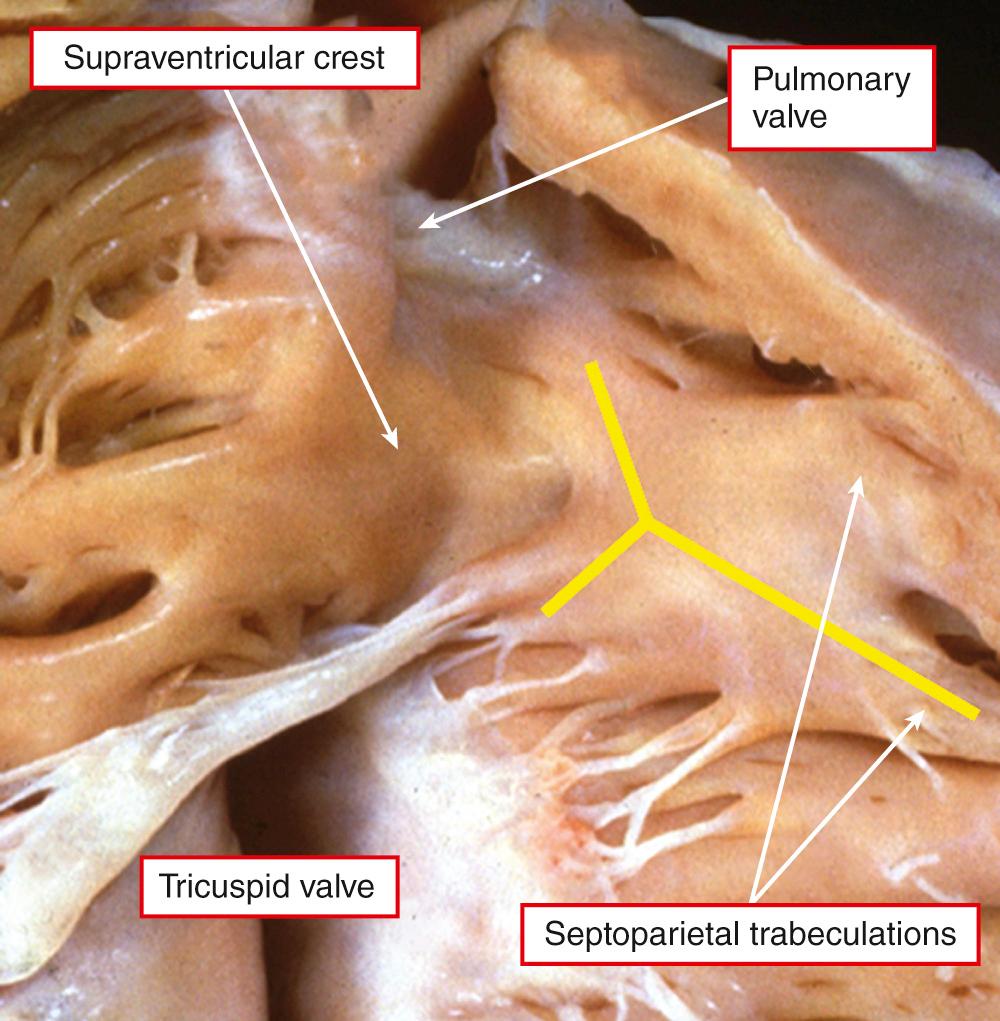
In tetralogy, these components of the normal supraventricular crest are separated. This permits the muscular outlet septum to be recognized in its own right, still supporting a freestanding subpulmonary infundibular sleeve but one that is also narrowed ( Fig. 35.3 ).
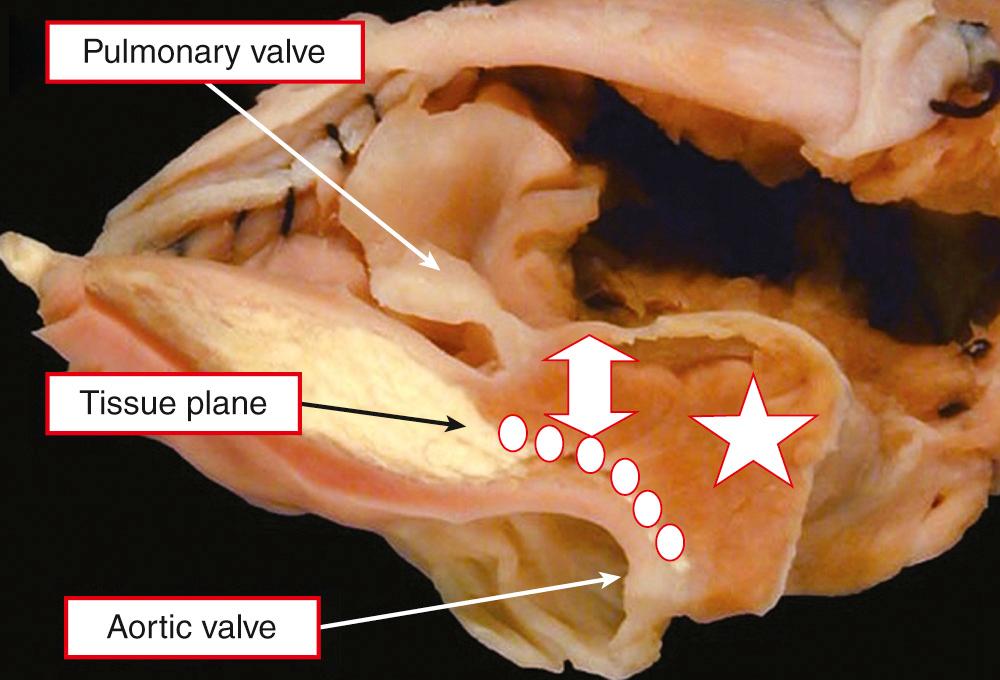
Because of the abnormal position of the outlet septum, which is exclusively a right ventricular structure, the channel between the ventricles opens on the right side between the limbs of the septomarginal trabeculation, with the right ventricular component of the overriding aortic root supported by the ventriculoinfundibular fold (see Fig. 35.1 ). The three anatomic features of the tetralogy therefore depend on the abnormal location of the outlet septum. This particular phenotypic combination cannot be produced in the absence of abnormal positioning and hypertrophy of the septoparietal trabeculations. The outlet septum, for example, can be markedly deviated in the anterocephalad direction without subpulmonary stenosis, as in the so-called Eisenmenger complex ( Fig. 35.4 ).
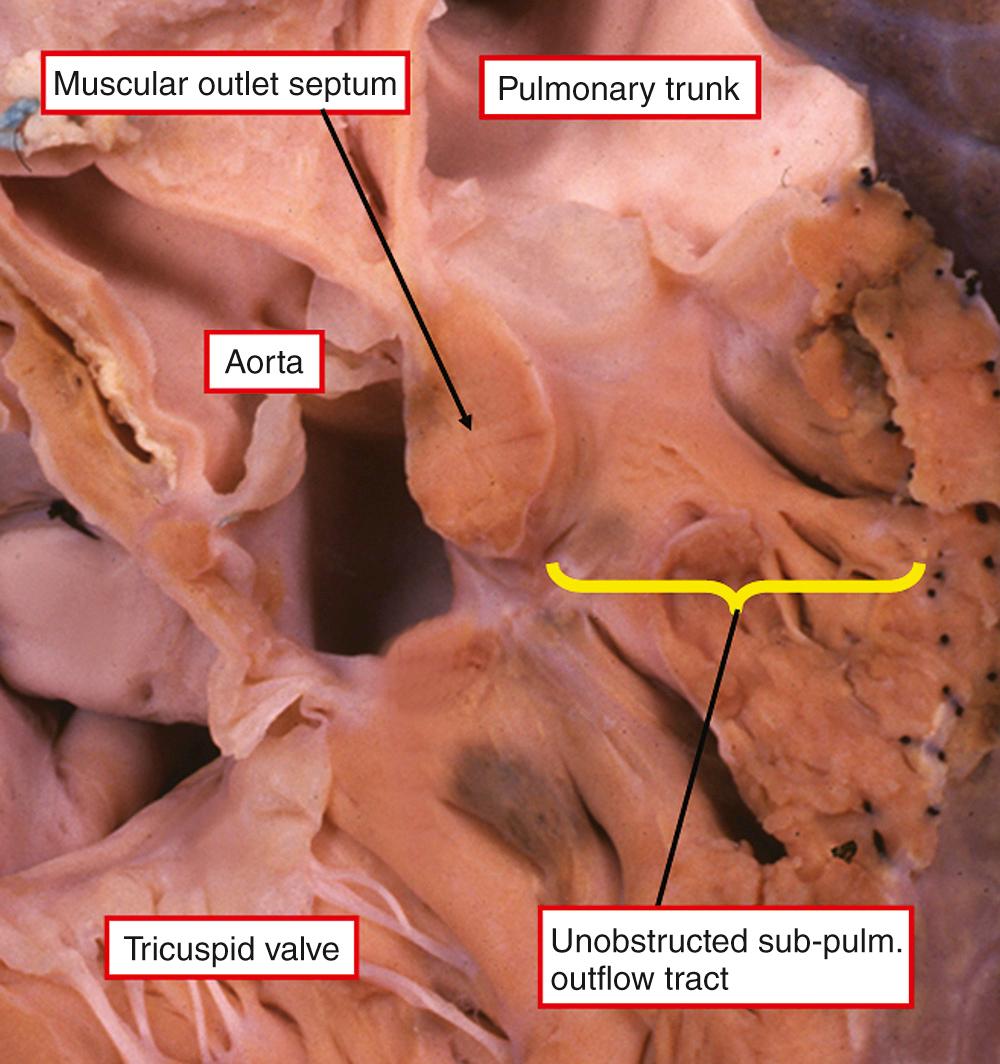
The separation of the outlet septum, ventriculoinfundibular fold, and septomarginal trabeculation is the essence of tetralogy. Despite each of these features now being recognizable anatomically in its own right, there have been significant confusion and controversy in the description of the abnormal outflow tracts. This is because each of these three structures, at various times and in various places, had been nominated as a component of the so-called crista. Consequently, when alleged parts of the crista were described in the setting of tetralogy, it was difficult to be sure which of the different structures was being described. Because of these problems, we suggested quite some time ago that the term “crista,” or its translation as supraventricular crest, be reserved for description of the muscular structure separating the attachments of the leaflets of the tricuspid and pulmonary valves in the normal right ventricular outflow tract ( Fig. 35.2 , left ; Fig. 35.5 , left ).
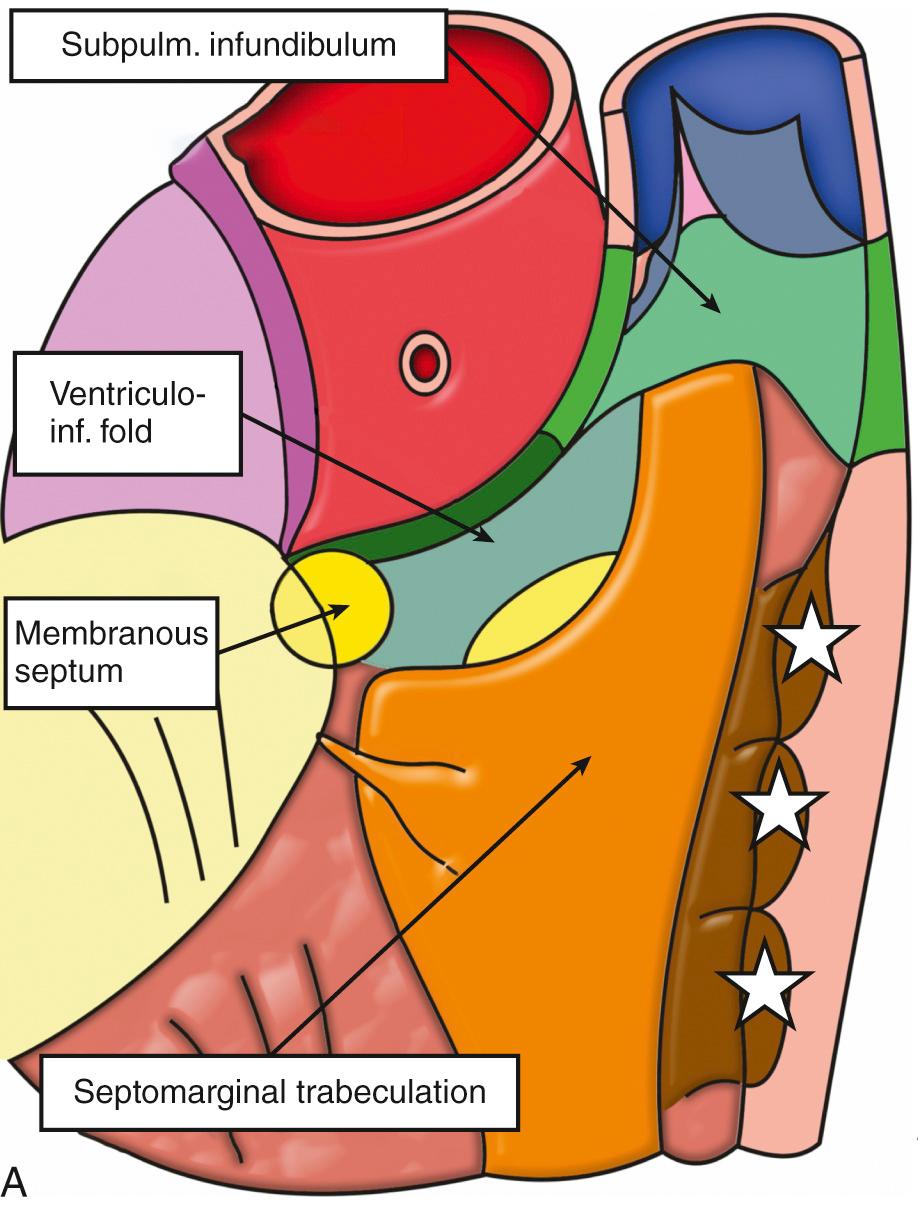
In situations where the muscular structures are separated one from the other, as is the case in tetralogy, and there is also a double-outlet right ventricle, it is best to account for each structure in its own right using descriptive and mutually exclusive terms ( Fig. 35.5 , right ). Thus the outlet septum is any muscular or fibrous structure that interposes between the subpulmonary and subaortic outflow tracts. It has septal and parietal insertions and supports distally the sleeve of freestanding subpulmonary infundibular musculature. The ventriculoinfundibular fold, being part of the muscular inner heart curvature, is a muscular structure that separates the leaflets of an arterial from an atrioventricular valve. The septomarginal trabeculation, or septal band, is the extensive muscular strap that reinforces the septal surface of the morphologically right ventricle. It has a body, together with anterocephalad and posterocaudal limbs. The channel between the ventricles opens to the right side between its limbs not only in tetralogy but also in other lesions such as double-outlet right ventricle and common arterial trunk. The septoparietal trabeculations arise from its anterior margin. They are integral components of the normal heart but are hypertrophied as part of tetralogy (see Fig. 35.5 ).
The channel between the ventricles is directly beneath the overriding aortic valvar orifice and hence is geographically an outlet defect. Its cranial border is the outlet septum, which is malaligned relative to the rest of the muscular septum. The outlet septum is usually muscular (see Fig. 35.1 , right ), but it can be fibrous and virtually absent in the doubly committed and juxta-arterial variant ( Fig. 35.6 ).
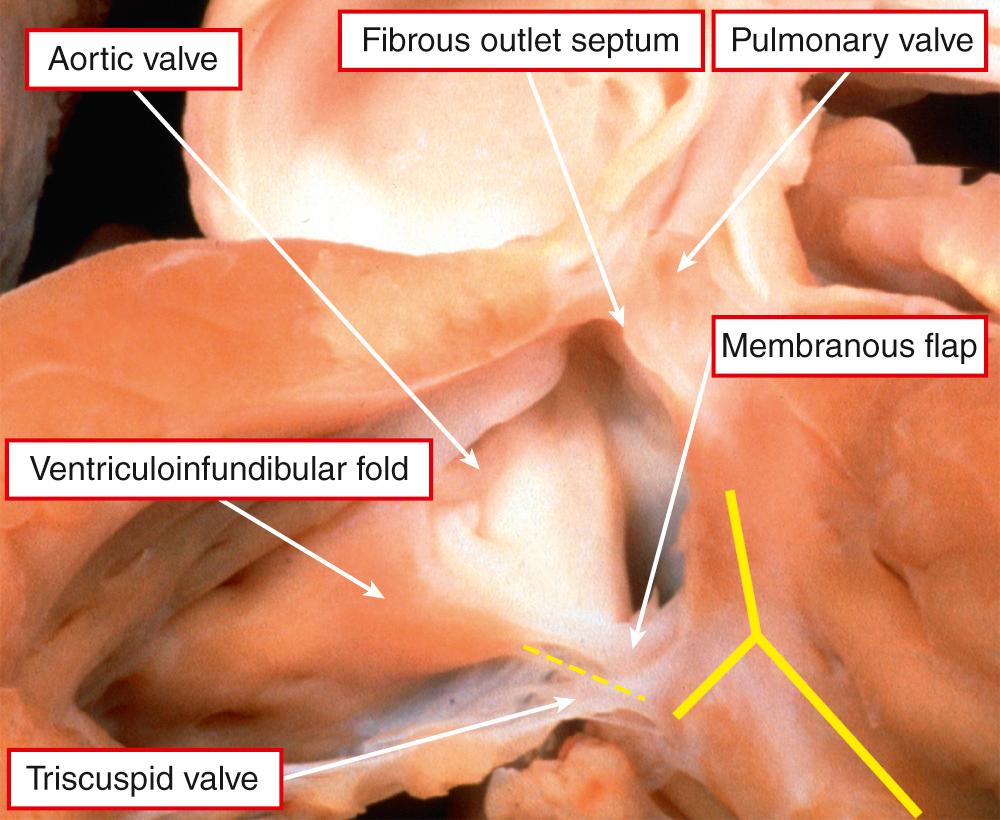
As we have emphasized, the essence of tetralogy is anterocephalad deviation of the septal insertion of the outlet septum, whether muscular or fibrous (compare Figs. 35.1 and 35.6 ). The crest of the muscular ventricular septum, reinforced by the limbs of the septomarginal trabeculation, forms the floor of the defect. The roof is formed by the attachments of the leaflets of the overriding aortic valve to the ventriculoinfundibular fold. The overriding nature of the aortic orifice, however, creates problems in defining specifically the area to be considered as the “ventricular septal defect.” Three potential areas can appropriately be described as the interventricular communication ( Fig. 35.7 ).
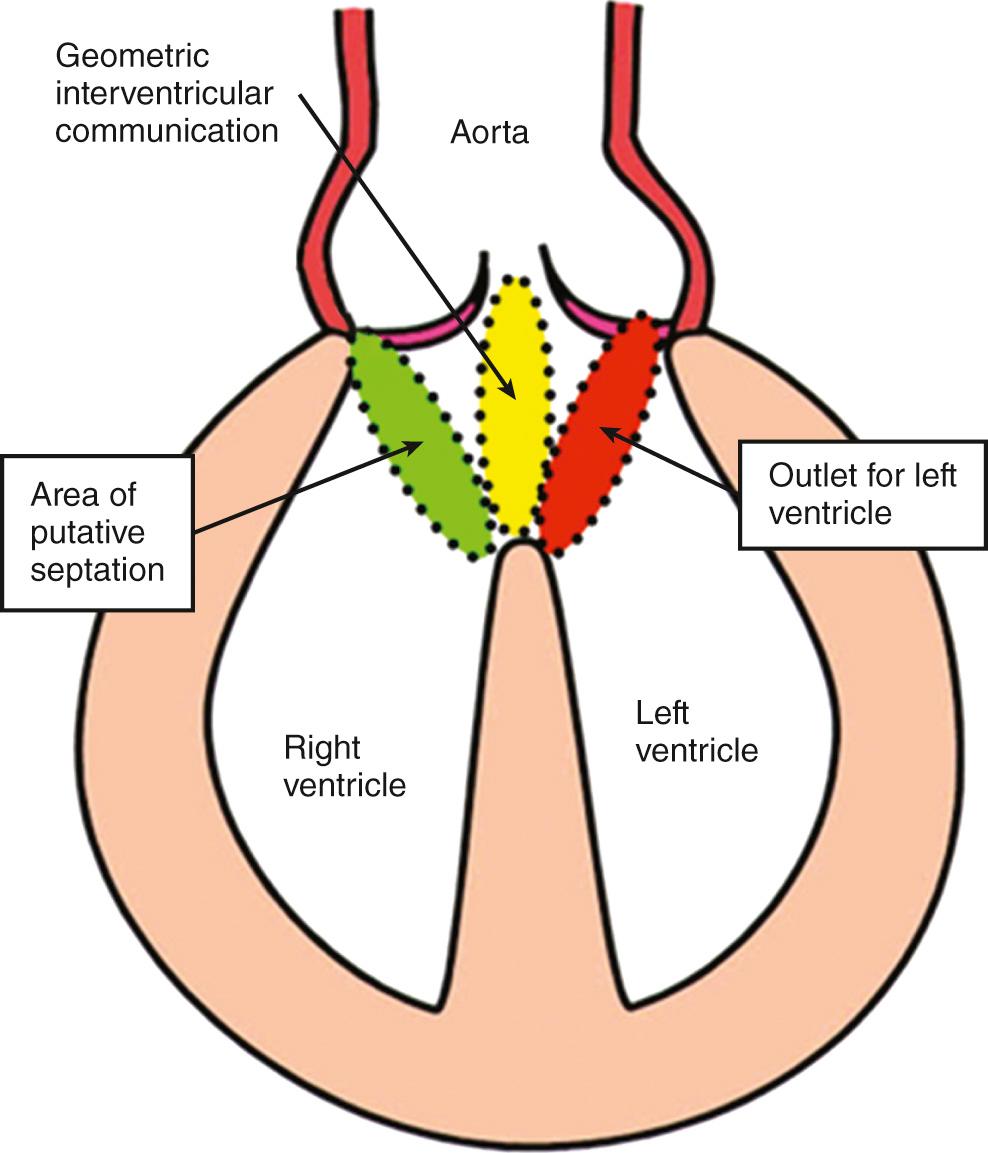
When describing the boundaries of these areas, we concentrate on the margins of the cone as viewed from the right ventricle, since this is the locus along which the surgeon will attach the patch used to repair the malformation. This area of putative ventricular septation is therefore defined as the ventricular septal defect. It has important variability not only in its roof (see Fig. 35.6 ) but also in its posteroinferior quadrant. In about four-fifths of cases, this margin is formed by fibrous continuity between the leaflets of the aortic, mitral, and tricuspid valves ( Fig. 35.8 , left ). The defect therefore is not only an outlet defect in this setting but is also perimembranous. It is directly comparable to typical perimembranous defects opening to the outlet of the right ventricle in the absence of subpulmonary obstruction (see Fig. 35.4 ). This means that the atrioventricular conduction axis is at risk in this fibrous posteroinferior margin (see Fig. 35.8 , left ).
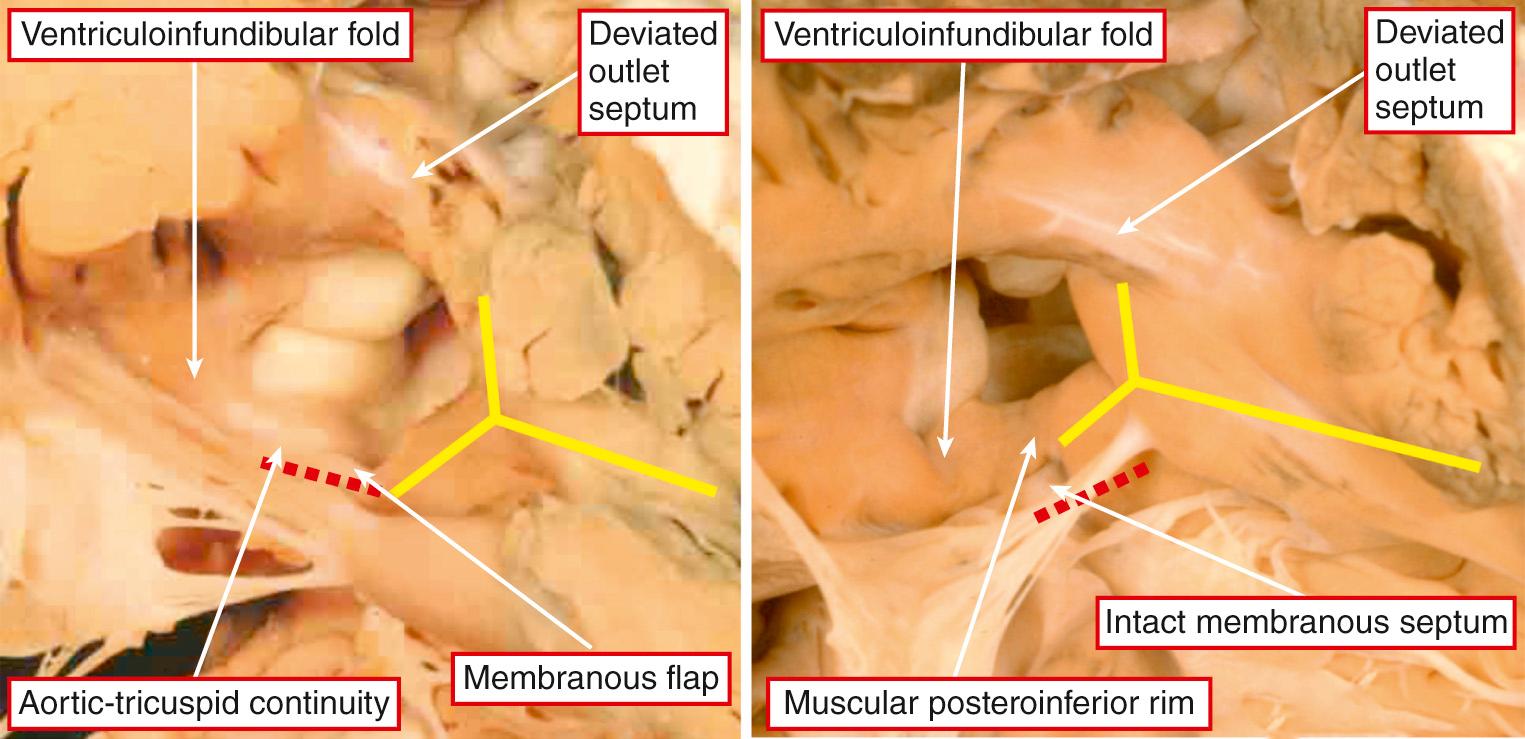
The bundle in the posteroinferior corner is frequently overlaid by a remnant of the interventricular membranous septum, which may, on occasion, become aneurysmal. The septal remnant itself, called the membranous flap , is safe tissue for anchorage of sutures when such stitches are placed with care. Sutures placed deeply in this area can produce complete heart block. It is therefore safer to place sutures through the leaflet of the tricuspid valve, which usually overlaps the membranous flap in this area of the defect. Having perforated, the nonbranching atrioventricular bundle enters the left ventricular part of the aortic outflow tract and almost always veers away from the septal crest, the branching atrioventricular bundle being carried on the left ventricular aspect of the septum and staying remote from the septal crest. In a minority of hearts, the bundle can branch directly astride the septum ( Fig. 35.9 ). Such an arrangement places the bundle at risk if sutures are placed into the crest of the septum.
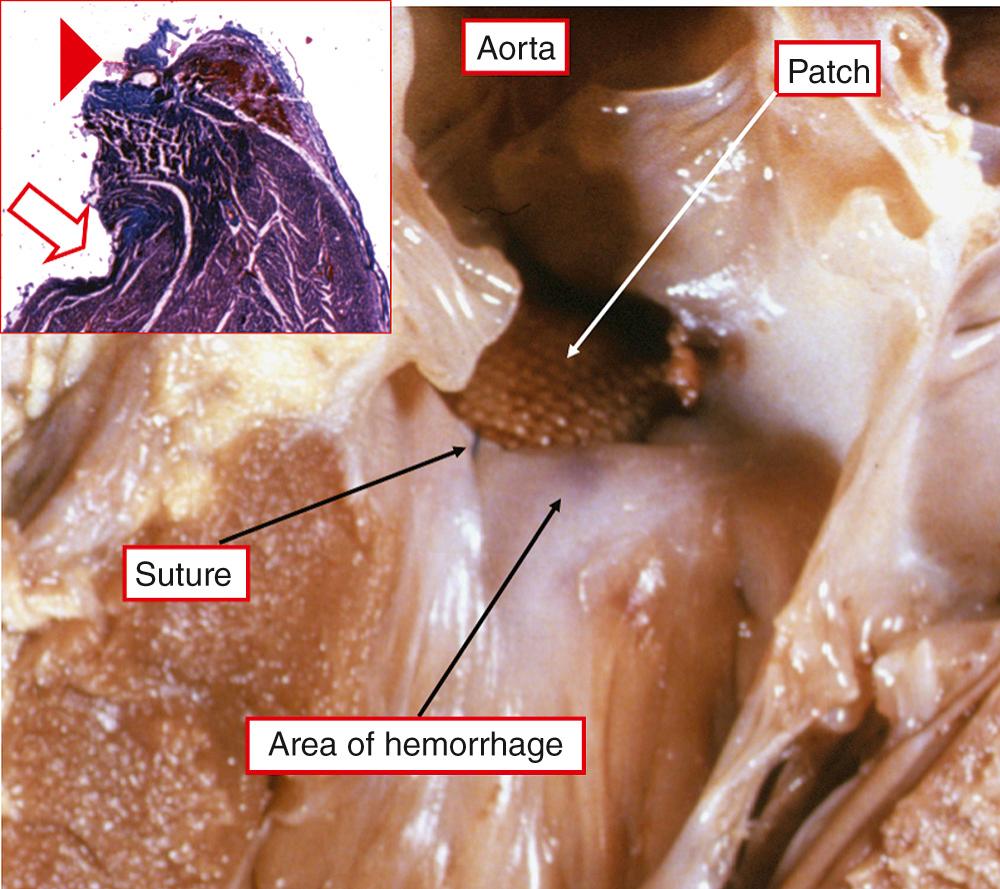
The second most common pattern, occurring in about one-fifth of cases, is characterized by interruption of the area of fibrous continuity between the aortic and tricuspid valves by a muscular strap. When viewed from its right ventricular aspect, the outlet defect has exclusively muscular rims. The strap itself is formed by fusion of the posterocaudal limb of the septomarginal trabeculation with the ventriculoinfundibular fold (see Fig. 35.8 , right ). An intact membranous septum is found between the muscular strap and the remaining septal structures. Since the atrioventricular conduction axis runs posteroinferior to the membranous septum, the muscular fold, together with the membranous septum itself, separates the conduction tissues from the crest of the ventricular septum.
As already discussed, a third variety of defect is characterized by the presence of a fibrous rather than a muscular outlet septum (see Fig. 35.6 ). These defects are doubly committed and juxta-arterial. They are by far the least common variants found in white populations but are more common in the Far East and South America. The defect exists because of failure of formation of a completely muscular subpulmonary infundibulum. Such defects can be found with fibrous continuity between the leaflets of the aortic and tricuspid valves, making them also perimembranous (see Fig. 35.6 ). More often there is a muscular posteroinferior rim, comparable to the muscular structure seen in the right panel of Fig. 35.8 . If present, the muscular structure will protect the atrioventricular conduction axis.
Patients with tetralogy, of necessity, possess one variant of the defects already described, all of which open to the right ventricle between the limbs of the septomarginal trabeculation. Additional defects can be found elsewhere in the septum. Inlet defects are particularly important, whether they are muscular inlet defects, defects associated with straddling and overriding of the tricuspid valve, or the ventricular component of an atrioventricular septal defect associated with a common atrioventricular junction. The septal defect is almost always large in tetralogy, approximating in size to the diameter of the aortic root. It can become restrictive owing to the presence of accessory fibrous tissue tags formed at the margins of the defect. Such tags may be derived in part from the tricuspid valve or extend from attachment of the tension apparatus of the mitral valve across the left ventricular aspect of the defect.
Subpulmonary stenosis, which is an essential part of tetralogy, is due to fixed and dynamic narrowing between the anterocephalad deviation of the outlet septum and the hypertrophied septoparietal trabeculations (see Fig. 35.1 , right ). The maximal area of stenosis viewed from the apex of the right ventricle typically produces an obvious mouth to the subpulmonary infundibulum, often called the os infundibulum . Additional stenosis can be found more proximally within the ventricle, produced either by hypertrophy of the moderator band, which is one of the septoparietal trabeculations, or by prominent apical trabeculations. This produces the arrangement described as a “two-chambered right ventricle.” The subpulmonary infundibulum itself varies markedly in length. In some instances, when the interventricular communication is doubly committed, the infundibulum is no longer exclusively muscular (see Fig. 35.6 ). In other instances, the narrowed infundibular chamber has considerable length. There is a spectrum between these extremes, but overall the infundibulum is longer in the setting of tetralogy, although it is narrowed compared with the normal heart. In addition to the muscular stenosis, it is also usual to find obstruction at valvar level, with the valve itself often possessing two rather than three leaflets. Further stenotic lesions can be found within the pulmonary arterial pathways.
In the normal heart, although the right aortic sinus of the aortic valve overrides spatially the crest of the muscular ventricular septum, the leaflets of the valve are attached exclusively within the left ventricle. Whenever the ventricular septum is deficient, however, part of the circumference of the aortic valvar orifice will be attached to and supported by right ventricular structures. Such aortic overriding becomes more obvious when the outlet septum is deviated so as to become exclusively a right ventricular structure, as in TOF (see Fig. 35.1 ) or the Eisenmenger ventricular septal defect (see Fig. 35.5 ). The precise degree of override—in other words, the proportion of the aortic valvar circumference supported by right as opposed to left ventricular structures—can vary between 5% and 100%. This feature has obvious surgical significance, since a much larger patch will be required to reconnect the aorta to the left ventricle when the larger part of its circumference is supported by the right ventricle. This feature also has implications for nomenclature, although its importance has been somewhat exaggerated. In Chapter 2 , we describe the situation in which more than half of the diameter of each great arterial valve is connected in the same ventricle as double-outlet ventriculoarterial connection. In the context of TOF, therefore, in which the entirety of the pulmonary valve is supported by the right ventricular subpulmonary infundibulum, if more than half of the leaflets of the aortic valve are hinged from right ventricular structures, we describe the situation as TOF coexisting with the ventriculoarterial connection of double-outlet ventricle. The two features can and do coexist.
Although the subpulmonary infundibulum is usually the narrowest part of the pulmonary outflow tract, other lesions are to be found elsewhere in the outflow tracts and the pulmonary arteries. Valvar stenosis is a frequent accompaniment. This is most frequently due to hypoplasia of the valve combined with stenosis of the leaflets of a bicuspid valve. The valvar lesion is rarely the only cause of obstruction, although in some young infants it can be the predominant finding. The valve can also become imperforate as an acquired change. “Absence” of the leaflets of the pulmonary valve is another important lesion. Most usually, the valve is represented by an annular array of fibrous rudiments usually found with dilation of the pulmonary trunk and its branches ( Fig. 35.10 ).
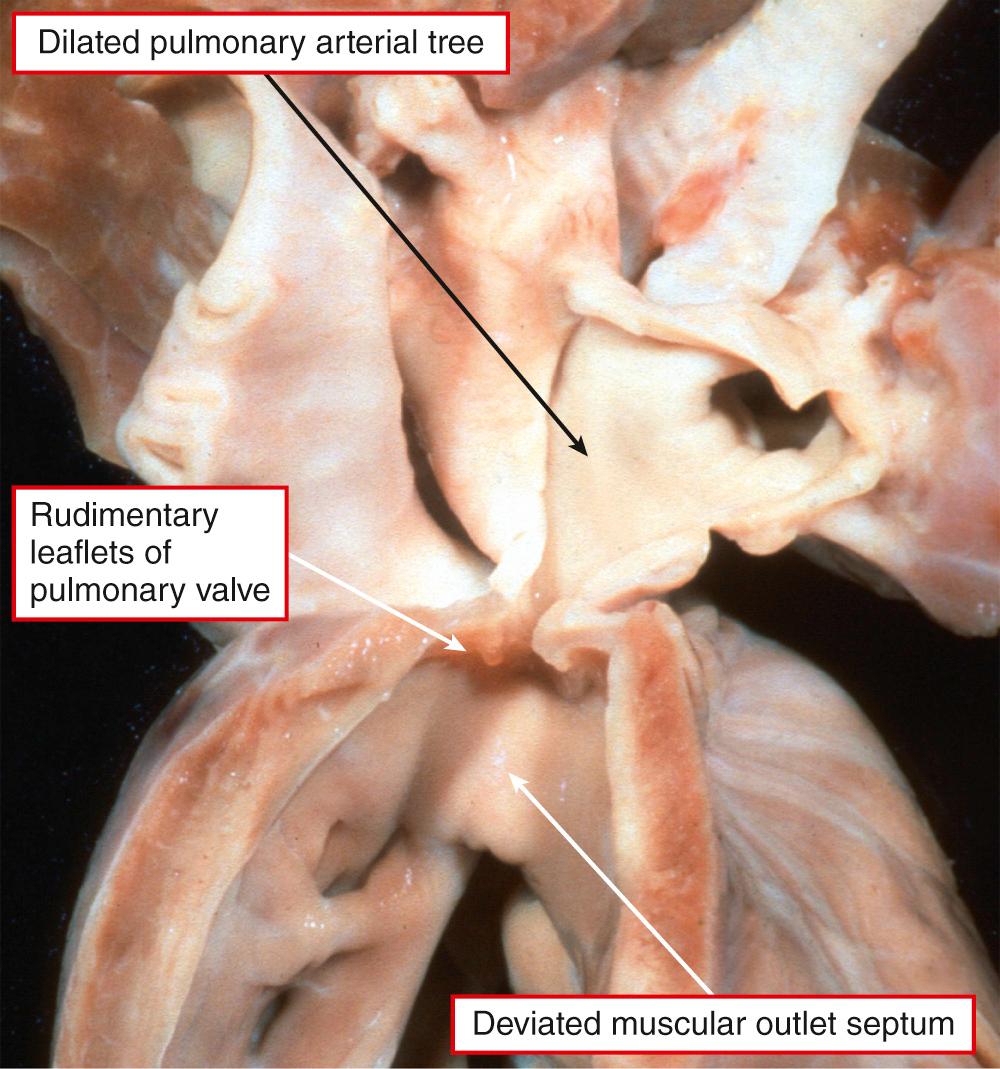
Stenoses within the pulmonary arteries themselves are of major surgical significance and usually occur at branching sites from the bifurcation outward. Lack of origin of one pulmonary artery, typically the left, from the pulmonary trunk is by no means infrequent. The isolated pulmonary artery is almost always present, usually being connected by the arterial duct or ligament to some part of the system of aortic arches. Rarely, one pulmonary artery may arise directly from the ascending aorta, but it tends to be the right artery, which is anomalously connected. Major systemic-to-pulmonary collateral arteries are sometimes present in association with tetralogy and pulmonary stenosis, but in association with confluent right and left pulmonary arteries. Such arteries can be the predominant or sole source of pulmonary arterial flow when tetralogy coexists with pulmonary atresia (see Chapter 37 ).
Many other lesions can coexist with tetralogy. Patency of the oval foramen is common, and a deficiency of the floor of the oval fossa is far from infrequent. In addition to a second inlet muscular ventricular septal defect, straddling of the tricuspid valve or the presence of a common atrioventricular valve, features already emphasized, the most important associated lesion from the stance of the surgeon is probably anomalous origin of the anterior interventricular coronary artery from the right coronary artery. A right aortic arch, though not of functional importance, is also common. When detected, it alerts to the diagnosis of tetralogy. Aortic dilation and valvar incompetence is more common in older patients.
The notion that TOF reflects malseptation of the arterial segment of the developing heart has a long pedigree and is supported by observations concerning naturally occurring infundibular lesions in Keeshond dogs. These animals show a spectrum of malformations, ranging from absence of the medial papillary muscle, through presence of an interventricular communication, to a constellation of anomalies similar to tetralogy. Study of embryos in which developmental stages of these malformations were observed, showed that the factory for production of the lesions was within the ventricular outflow tracts. Specifically, abnormalities were found in the formation and position of the endocardial cushions, which normally fuse to septate the ventricular outlets. These observations were confirmed in rats dosed with bis-diamine, with further evidence demonstrating muscularization of the proximal outflow cushions to form the subpulmonary infundibulum of the normal heart provided by observations in the developing human heart ( Fig. 35.11 ).
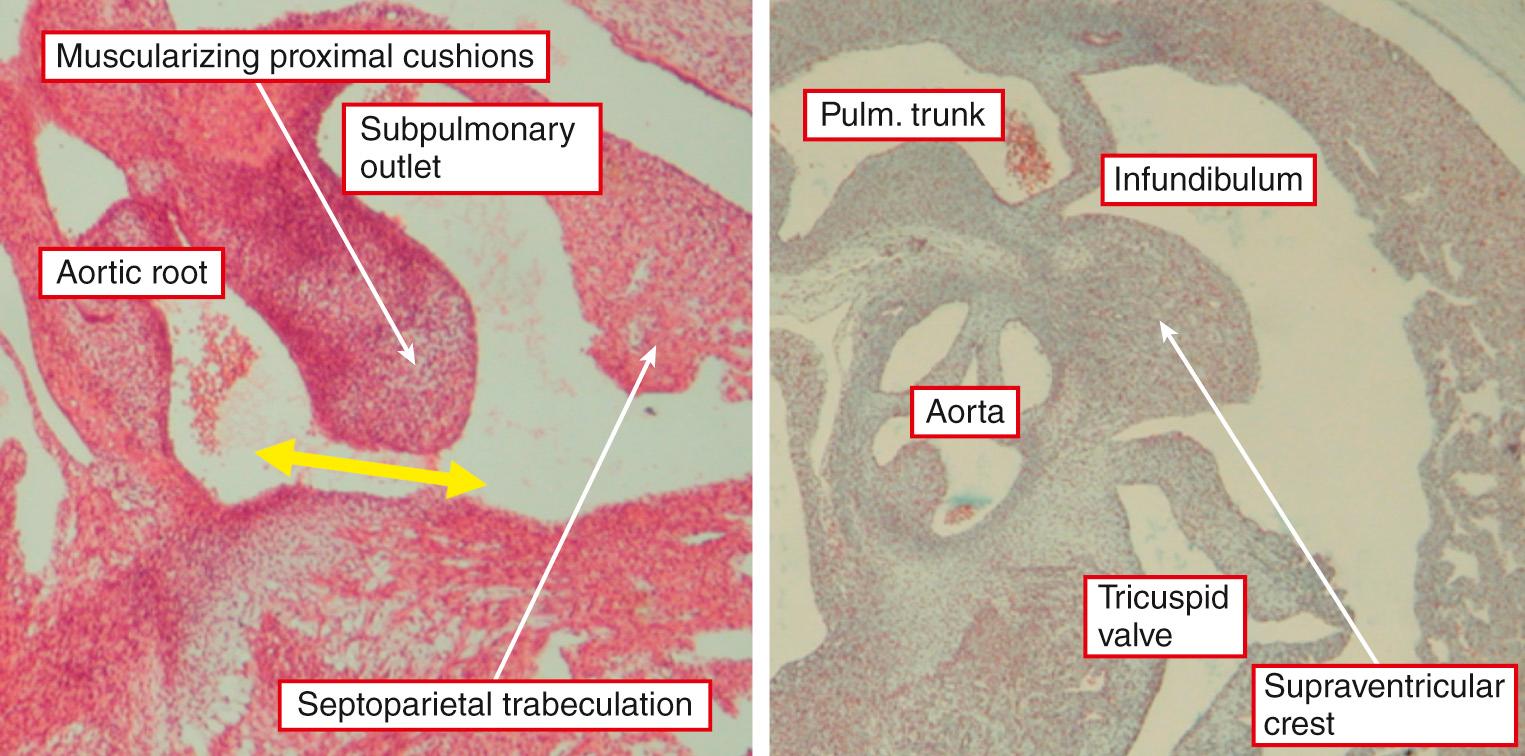
The findings in patients with deletion of chromosome 22q11 also support the existence of malseptation of the outflow tracts in humans and point to this being due to problems in the migration of cells from the neural crest. Based on the anatomic findings, therefore, it can be said with some degree of certainty that there is malseptation of the ventricular outlets and the arterial pole of the heart at the expense of the pulmonary trunk, together with failure of normal incorporation of the aortic outflow tract into the morphologically left ventricle. As discussed, the abnormal attachment of the muscular outlet septum is sufficient to account for the presence of the interventricular communication and the biventricular connection of the aorta, but production of subpulmonary muscular stenosis requires additional hypertrophy of the septoparietal trabeculations. The right ventricular hypertrophy is simply a hemodynamic consequence of the anatomic lesions.
The clinical presentation is dominated by the degree of muscular obstruction of the right ventricular outflow tract. This is sometimes modified by associated anomalies, such as persistent patency of the arterial duct, or presence of large systemic-to-pulmonary collateral arteries.
When the obstruction of the right ventricular outflow tract is severe at birth, presentation is in the neonatal period. Persistent cyanosis becomes apparent within the first few hours or days of life. With severe arterial desaturation, a metabolic acidosis develops that is compensated by an increased respiratory rate. The concomitant fall in arterial content of carbon dioxide gives rise to a compensatory respiratory alkalosis. Intercostal or subcostal recession, however, is unusual. Cyanosis, which dominates the clinical picture, increases with crying, feeding, or other activities. At least initially the baby does not appear unduly distressed. Sometimes the pulmonary circulation is duct dependent. In this setting, the degree of subpulmonary obstruction is so great that there is inadequate antegrade flow, and virtually all pulmonary blood flow is derived from a left-to-right shunt via the arterial duct. Under such circumstances, spontaneous closure of the duct results in death. Maintenance of ductal patency, usually by the infusion of prostaglandin E, is crucial (see later).
The majority of children with TOF are acyanotic at birth. Consequently they often present because a systolic murmur is detected during routine examination. The development of cyanosis is dependent on increasing infundibular stenosis and not on the degree of aortic override. This is usually noted within the first few weeks of life, but development of cyanosis may rarely be delayed to late childhood. The systolic murmur, present in all patients other than those with very severe stenosis or acquired atresia, originates at the site of subpulmonary obstruction and not because of flow across the ventricular septal defect. At this stage, infants or children are usually asymptomatic. Later, hypercyanotic spells or squatting on exercise may all occur (see further on). With improved medical surveillance, all of these symptoms are now less often encountered than even a decade ago.
Some infants with tetralogy may uncommonly present at the age of 4 to 6 weeks with features indistinguishable from those of a large ventricular septal defect (see Chapter 28 ). These babies are breathless, feed poorly, gain weight poorly, and are not cyanosed. With increasing right ventricular hypertrophy, the subpulmonary obstruction becomes more marked and, as the shunt is reversed, the patients exhibit signs and progression as described for the group with moderate obstruction.
When tetralogy is complicated by so-called absence of the leaflets of the pulmonary valve, which are usually present in rudimentary form, the presentation is characteristic yet different from the previously described groups. The majority with this complication present in infancy with respiratory symptoms of inspiratory and expiratory stridor, dyspnea caused by lobar collapse, or sometimes lobar emphysema. These features reflect compression of the bronchial tree by the grossly dilated proximal pulmonary arteries. Although bronchial obstruction may lead to lobar collapse and subsequent infection, partial obstruction may produce a ball-valve effect, resulting in emphysema. Because there is stenosis at the site of the rudimentary leaflets of the pulmonary valve, symptoms directly related to abnormal hemodynamics are unusual.
Squatting, along with other postures, may alleviate the degree of cyanosis, dyspnea, or feeling of faintness induced by exercise. The means by which squatting alleviates the symptoms of cyanosis and dyspnea have caused considerable debate. Irrespective of the precise mechanisms, there is little doubt that squatting causes an abrupt increase in systemic venous return and a rise in systemic vascular resistance. Right-to-left shunting is decreased by an increase in systemic vascular resistance. This results in immediate improvement of effective pulmonary blood flow and an increase of arterial oxygenation.
An important and sometimes dramatic feature of patients with tetralogy is the occurrence of unprovoked severe cyanosis, which may lead to reduced cardiac output and be accompanied by transient loss of consciousness. These episodes, which are most common between 6 months and 2 years of age, are potentially dangerous, as they may lead to cerebral damage or even death. The majority last between 15 and 60 minutes, but an individual spell may be of shorter duration or can last for several hours. Initial presentation of infants or children may be with a history of episodic loss of consciousness or convulsions, episodes of going floppy or pale, transient vacant episodes, or episodes of becoming deeply cyanosed followed by loss of consciousness or sleep. Another striking feature of these spells may be episodes of very rapid deep respiration or hyperpnea or a high-pitched abnormal cry. The episodes are usually sufficiently dramatic or unusual for parents to volunteer information, but specific questioning concerning their presence should be part of every outpatient assessment. In 1958, Wood postulated that the spells resulted from infundibular spasm or shutdown. Many now believe that the concept of infundibular “spasm,” considered as a primary phenomenon, is unsupported by the anatomy or physiology of the subpulmonary infundibulum. They suggest that the “shutdown” is secondary to other primary physiologic influences, such as dehydration, or tachycardia-induced reduction in right ventricular preload, systemic vasodilation in response to fever, or other sympathetic activity. Irrespective of their etiology, the occurrence of such episodes should lead to prompt treatment with continuous beta blockade and referral for surgery or interventional catheterization as dictated by the institutional protocols.
The essential abnormal cardiac findings in the neonate with severe TOF are cyanosis and, on auscultation, a systolic ejection murmur with a single second heart sound. Overt clubbing of the fingers and toes is typically not detected until 2 or 3 years of age; therefore it is unusual today in the West. The baby may grow normally, although a higher proportion weigh less than would be expected. Some degree of facial dysmorphism is quite common, and typical features of associated syndromes may be obvious, such as DiGeorge, Goldenhar, or Down syndromes. All patients should undergo chromosomal analysis on presentation with specific fluorescent in situ hybridization for the 22q11 deletion. Pulses are almost always normal in all limbs, aortic coarctation being exceedingly rare in symptomatic neonates with TOF. The cardiac impulse may be normal, or the parasternal right ventricular impulse may be increased. The first heart sound is normal, but the second is characteristically single. In contrast to patients having pulmonary stenosis with an intact ventricular septum, pulmonary ejection sounds in the second or third intercostal space or third and fourth heart sounds are virtually never found in children with tetralogy. An aortic ejection click may sometimes be heard at the lower left sternal edge or the apex. The duration of the systolic ejection murmur will vary depending on the degree of infundibular stenosis. The shorter the murmur, the tighter the stenosis and, in turn, the greater the cyanosis. Coexisting “absent pulmonary valve syndrome” is characterized by an additional long, loud, early diastolic decrescendo murmur from pulmonary regurgitation, which should be easily distinguishable from a continuous murmur. When a loud continuous murmur is heard in the neonatal period, and clinical features are otherwise compatible with the diagnosis of tetralogy, it is more likely to originate from flow through major aortopulmonary collateral arteries than the arterial duct. The patient is likely to have coexisting pulmonary atresia. In these patients, cyanosis may not be so marked since pulmonary blood flow is more adequately maintained through the collateral arteries.
Children with tetralogy in whom subpulmonary obstruction is minimal or absent at birth exhibit tachypnea, dyspnea, and intercostal or subcostal recession. This group has a large left-to-right shunt, with an increased flow of blood to the lungs. A prominent parasternal impulse and hepatomegaly may be present. On auscultation, the second sound is split, possibly with an accentuated pulmonary component.
Become a Clinical Tree membership for Full access and enjoy Unlimited articles
If you are a member. Log in here